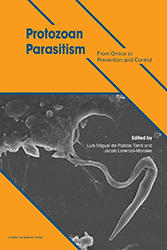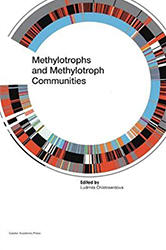Reviews
Issue: Why Microbiology Matters
05 May 2020 article

Protozoan Parasitism: From Omics to Prevention and Control
Edited by Luis Miguel de Pablos Torró and Jacob-Lorenzo Morales
Caister Academic Press (2018) £159
ISBN 978-1-910190-83-8
Protozoan parasites are responsible for many serious diseases around the world, including Chagas disease and leishmaniasis. This short, edited volume aims to provide a background and historical context to the current treatments for many of these diseases and to investigate how genome-wide approaches are helping to develop new therapeutics. On the whole I think this aim is achieved, though it is limited by the relatively few organisms that are considered.

The book is split into nine chapters, each written by an expert on the topic covered. However, there is a heavy emphasis on Trypanosoma cruzi and Leishmania spp. with the first six chapters focused on these organisms: this skew leads to an element of redundancy and repetition in these earlier chapters. The final three chapters investigate the progress made in the treatment and control of Naegleria fowleri, Entamoeba histolytica, and Acanthamoeba, which are relatively understudied yet still cause serious diseases. Each chapter has a different angle but all describe the current approaches that are being used to identify either potential therapeutic targets using genome wide approaches (proteomics,
transcriptomics, etc.) or potential treatments using high-throughput screens.
I found this book well written, clear and accessible; it provides a useful background to the organisms themselves, as well as to the treatments that are currently used and their limitations. This book will be a useful resource for many scientists at all levels, especially those new to any of the organisms covered. Moreover, despite the progress being made, the volume highlights just how far we have to go before we have new safe and effective treatments for these parasites.
Jack Sunter
Oxford Brookes University, UK

Forensic Microbiology
Edited by David O. Carter, Jeffery K. Tomberlin, M. Eric Benbow and Jessica L. Metcalf
John Wiley & Sons Ltd (2017) £94.75
ISBN 978-1-119062-55-4
Forensic microbiology is a rapidly evolving scientific discipline. The ever-increasing threat of bioterror and biocrime means that the rapid identification and subtyping of infectious agents is more important than ever before. In the past 15 years, and particularly due to the anthrax letter attacks in the United States, forensic microbiology has seen significant developments in technology. Mainly, massively parallel sequencing and bioinformatics advances now allow characterisation of microbial communities for a variety of human forensic applications and in a multidisciplinary context.
Forensic Microbiology was published as part of the Forensic Science in Focus series, a joint venture between the American Academy of Forensic Science and Wiley. This book provides a comprehensive overview of the forensic applications of microbiology associated with pathology, taphonomy, anthropology and trace evidence analysis. A broad variety of topics are covered, ranging from experimental design, sample preservation and data analysis, through to the existing and newly emerging molecular methodologies, to application of these to crime scene analysis. Microbial impacts in post-mortem toxicology, a chapter that discusses how microbe action can alter the identification of drugs and metabolites in a body after death, is particularly well-structured and informative. Overall, the book describes the advances, as well as the challenges and future perspectives in the field of forensic microbiology. The text is well written but requires a basic understanding of molecular biology and protein chemistry. The high-quality content of the book makes it an attractive resource to both students and established researchers. It will also be of great value to microbiologists and pathologists, as well as to forensic investigators.
Magdalena Karlikowska
University of Warwick, UK

The Power of Plagues (2nd Edition)
Written by Irwin W. Sherman
ASM Press (2017) £30.50
ISBN 978-1-683670-00-1
A fascinating guided tour through a museum of infections, showing us some of the major influencers of societal change; The Power of Plagues tells us the story of how the emergence and spread of infectious diseases have in turn caused humans to change and adapt in both biology and culture. Irwin W. Sherman narrates the history of human society, the suffering caused, and how the modern world we know today has been shaped by outbreaks of these infectious diseases.
The book details the significant historical moments in our history influenced by infections; fascinating and accessible to any reader. We are guided through the impact of the Black Death in Europe, the conquest of South American civilisations by infection and the insidious spread of HIV across the world. The historical narrative is complemented by beautiful illustrations and examples of artwork depicting these events, as well as quotes and writings of the people who were there to see them with their own eyes. History is interspersed with important scientific and technical information that Sherman has carefully explained so that even those unfamiliar can learn the fundamental science behind infections. Furthermore, the narrative of scientific discovery gives the reader insight into the politics and intrigue of scientific discovery.
Sherman has written an engaging piece that I struggled to put down, and through which I learnt fascinating details about infections that I’d never learn about in an ordinary textbook. Even those who study and work in the field of infectious disease would likely learn some insightful anecdotes and surprising stories from this book.
I encourage not only those with an interest in infectious diseases and microbiology to read this book, but anyone with an interest in our history; to better understand how the smallest things can bring about so much upheaval and change, and how we should respect and fear the power of plagues, and the dangers they pose even in our modern world.
Andrew Bosworth
NIHR Health Protection Research Unit, Public Health England

Cyanobacteria: Signalling and Regulation Systems
Written by Dmitry A. Los
Caister Academic Press (2018) £259
ISBN 978-1-910190-87-6
The role of cyanobacteria in oxygenating Earth’s atmosphere and producing as much oxygen as plants sets the microbe apart in Earth’s evolution and biogeochemical cycles. Ease of genetic manipulation coupled with various –omics methods have helped unravel many signalling and regulatory mechanisms in cyanobacteria, including that of the stress response. In this book, the author, Dmitry A. Los focused on stress response and various regulatory mechanisms in cyanobacteria to combat such stress.
The first two chapters of the book focused on transcriptomics and proteomics studies in cyanobacteria by various stress factors including temperature, salt, oxygen, light, acid, water and hydrogen peroxide. The author then discusses the role of two-component regulatory systems, eukaryotic serine/threonine kinases and phosphatases, sigma subunits of RNA polymerase, transcription factors and other regulators in adaptation of cyanobacteria to changing environments. The book concludes with a chapter on applications of cyanobacteria in biotechnological processes, such as production of renewable biofuels and chemicals by genetic alterations of metabolic pathways.
The book is lucidly written with enough illustrations and historical background to stimulate interest among readers in cyanobacteria. This book will be useful to graduate students, academics and researchers interested in recent advances in cyanobacterial regulatory systems.
Arindam Mitra
Adamas University, India
Methylotrophs and Methylotroph Communities

Edited by Ludmila Chistoserdova
Caister Academic Press (2019) £199
ISBN 978-1-912530-04-5
Methylotrophs and Methylotroph Communities is a new text that aims to provide an overview of the topic of methylotrophy, including the significant updates that have occurred in recent years. The book is organised into a series of chapters that vary in their focus, from broad environmental topics, to the characterisation of specific organisms. The selected authors represent both the more experienced and the newer ‘methylotrophysts’, providing fresh and well-developed perspectives on the multiple topics.
For those interested in the field of methylotrophy, this text provides an essential and comprehensive review of the field, with effective descriptions of the multiple pathways and genes, including in-depth descriptions of more recently identified metabolisms and enzymes. This book also has relevance for the broader microbiology community, with the different chapters touching on a range of subjects, such as elemental cycles (sulfur, carbon, nitrogen and halides), synthetic ecology, taxonomy, the role of horizontal gene transfer in shaping evolution, as well as medical and industrial applications of this group of organisms and their metabolites. Most chapters include a description of the current uncertainties and unknowns within the field, with discussion throughout the book on the role of cultivation-independent and cultivation-dependant techniques in furthering microbiology and solving these unknowns. This book represents the most thorough and essential text on methylotrophs since The Biochemistry of Methylotrophs was first published in 1982, and would easily work as a recommended text for any environmental microbiology course.
Michael Macey
The Open University, UK

Pathogenic Escherichia coli: Evolution, Omics, Detection and Control
Edited by Pina M. Fratamico, Yanhong Liu and Christopher H. Sommers
Caister Academic Press (2018) £159
ISBN 978-1-910190-77-7
Since its first association with human disease in the 1940s, when John Bray identified enteropathogenic Escherichia coli as the causative agent of a UK outbreak of summer diarrhoea in infants, much has been learned about the different pathotypes of E. coli which can cause both intestinal and systemic disease. However, with recent technological advances, including next-generation sequencing, multi-omics, and in silico modelling approaches, our understanding of the evolution and enormous versatility of this group of pathogens has increased enormously. This book provides a timely update on the potential of these novel methodologies for the development of efficient prevention and treatment strategies against pathogenic E. coli infections. After an initial overview of the different E. coli pathotypes/hybrids and their virulence strategies, the reader is introduced to current progress in phage therapy and refined detection methods for pathogenic E. coli.
In the subsequent chapters, the potential of whole genome sequencing for pathogen detection, tracing of outbreaks and elucidating mechanisms of pathogenesis is discussed. In addition, the applications of multi-omics analysis to understand pathogen adaptation to stresses in the food chain and development of dormant persister cells are examined. All in all, this is a very valuable book for every scientist and student interested in E. coli pathogenesis and the use of modern technology to improve pathogen detection, diagnosis and infection treatment and prevention.
Stephanie Schuller
Norwich Medical School, University of East Anglia
